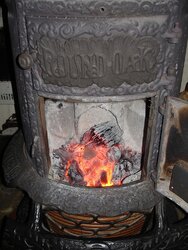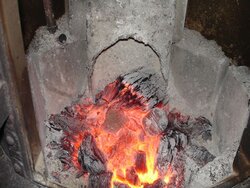Frostbit said:
Well, here goes. I established about an 1 1/2" bed of coals, though not over the entire bottom. My F400 primary was at full left, which is "closed". I opened the door with the IR gun in hand, and direct in the glowing coals it was 1150 degrees. In very short order (the door is now open), maybe 15-20 seconds, the temp ran right on past 1200, then 1300. 1350-1370 was prominent for a short while, then I had two over 1400, as the screen went blank. It would have been interesting to see just how high it would climb to, but just not possible with this gun, or with the door open.
That's all I could do, Peter.
Frostbit:
This is music to my ears... or eyes. For twenty years, I've been in the dark about this... only had 'suspicions'.
My final baffle design (as described) was sort of an act of desperation, because other trials (all involving only upward flow through the stove) had never allowed me to control the rate of burn in the Round Oak. Even with other flow restrictions and a flue damper (I think I even tried two dampers at one point), I could still get runaway fires. So simply improving control was my primary goal... and the low entry point of the baffle seemed to provide that. While I had an idea that the coal bed was 'pretty hot', I've never been sure (before now) that the temperature was sufficient 'on paper' to support secondary combustion.
Though I did (and still) introduce some additional 'overfire' air, I don't think I've ever concentrated enough adequately preheated air to the immediate vicinity of the baffle entry. I'm now going to try to do so. The 'plumbing' will be a bit of a problem (because I don't much want to drill holes in the stove body), but not insurmountable. I can't readily preheat incoming air from the stove's existing draft controls. And I may not be able to try anything new this season (it's going to be double digits below zero here tonight and tomorrow night), but I'll definitely be ready for next year... at the latest.
The two (other) main drawbacks to the current setup are that (of course) a good, hot coalbed has to be built up before any secondary combustion is likely, and the baffle could really use some sort of bypass (reloads can be a bit smoky at times).
And there's some lingering doubt in my mind whether heat transfer from the stove is as effective as it could be, given that the baffle is isolated/insulated from contact with the stove body itself for much of its length.
Again, my original 'R & D' efforts were dictated by the fact that the stove was far from airtight, required vertical wood stacking (and burn pattern), and had absolutely no internal baffling to begin with... the flame (along with all the unburned volatiles) just shot right up the flue. Pretty much the only sort of fire that could be had was 'flat out'... and fast.
Anyways... just thinking out loud...
Having the coal temps bracketed (at least at the low end) is of real use to me for further thought and trials. I will - at the very least - now be pushing coals towards the throat of the baffle on reload... I never bothered before.
Thanks very much (once again) for your time and the 'vicarious' use of the Raytek Raynger. I owe you.
Peter B.
--
Cowboy Billy: I think I answered your last question in this post. Good luck with your own Round Oak, but be gentle with it, if it's complete, it's worth something on resale to a restorer.
-----



